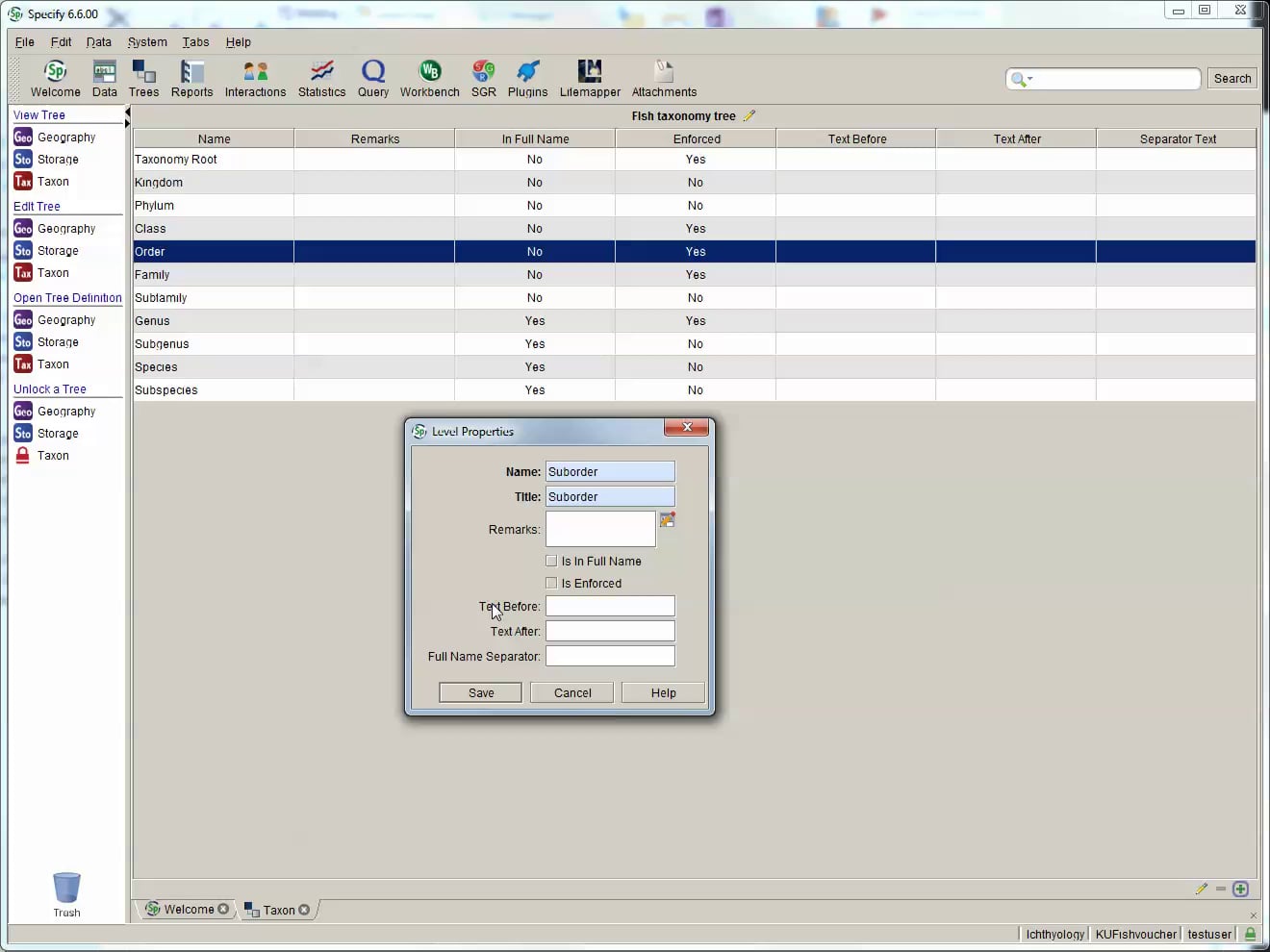![]() Specify 7 Instructions
Specify 7 Instructions
![]() Specify 6 Instructions
Specify 6 Instructions
Editing a Tree Definition
The Tree Definition tool defines the levels, or ranks available in a tree as well as how these ranks are enforced during data entry, and used in aggregating the full name. Tree Definition tools are available for each of the trees. Nodes can not be added to a tree unless the rank is included in the tree definition.
This video shows how to modify the taxonomy, storage, or geography trees in Specify 6.
The Tree Definition is configured during both the Specify Setup Wizard and the Discipline Wizard that is run when a Discipline is added. The Tree Definition can be edited from within Specify as well.
Click the Trees button on the task bar, then select a tree from the side bar list under Open Tree Definition.
The resulting window displays a hierarchical list of included Ranks in a grid view.
A tree and corresponding form may not be open at the same time. If either a tree or form is open, the other will only be available in view mode. For example, if user A is editing the Taxon tree, user B will not be allowed to edit a Taxon form.
Also, a tree and tree definition representing the same table can not be open at the same time. If the tree definition is open and the tree is selected the tree will replace the tree definition in the same tab, therefore closing the tree definition. The tree definition is not available to View and those without editing privileges may not access it.
Edit a Tree Title
Click on the ![]() (edit) button next to the tree title to edit the title of the tree. This is also the name that will be given to the first node in the tree.
(edit) button next to the tree title to edit the title of the tree. This is also the name that will be given to the first node in the tree.
Edit / Add / Delete Ranks
Buttons for editing (![]() ), and adding (
), and adding (![]() ), deleting (
), deleting (![]() ) ranks are located at the bottom right of the Workspace window.
) ranks are located at the bottom right of the Workspace window.
Select a rank, then either double click to edit the rank or select edit or add to open the Rank Properties dialog. New ranks will be added below the selected rank; therefore, select the parent of the rank you wish to add.
- Name refers to the name of the rank used internally by Specify but not visible to the user.
- Title is the name of the rank displayed to the user in the tree, queries and reports.
- Remarks allows remarks to be entered regarding the rank.
- In Full Name will use the rank when displaying the full name for any associated Collection Objects (which appears in the Taxon Full Name field of the taxon table). The Full Name is also displayed in the Preferred Taxon field on the Determinations form and is useful when running queries and reports when the full name is desired.
- Enforced ensures that the Rank can not be skipped when attaching children.
Click the delete button to delete a rank. Ranks may NOT be deleted if nodes are associated with them. It is important to remember that the Institution tree is shared by all collections in an institution and all other trees are shared by all collections within a single Discipline. Ranks that are not being used by your collection may have associated nodes in other collections and therefore can not be deleted.
Once the change is saved the tree will update. If the tree is extremely large, this may take several minutes.
Update Trees
Anytime a tree is edited it is also updated within the database. If this process is interrupted, the tree will need to update when Specify re-launches. A prompt will appear notifying the user that the tree is updating. A manual update can also be performed by clicking System > Trees > Update (tree type) Tree.
Predefined Ranks
Taxon, Chronostratigraphy, Geography and Lithostratigraphy include predefined ranks for the tree definitions. The Geography, Chronostratigraphy and Lithostratigraphy predefined ranks are also active within the tree definition. The Taxon tree includes many ranks that are not active and are offered via a Predefined Ranks dialog when adding a Rank. If the list does not include the desired Rank, one can be added by clicking the Custom button and naming the rank in the ensuing Edit Rank Properties dialog.
If predefined ranks are deleted from the tree definition, they will be added back into the Predefined Ranks list in the dialog.
Whenever possible, it is highly recommended that users choose a predefined rank rather than create a custom rank.
There is a limit to the number of custom ranks available between each predefined rank. When custom ranks can no longer be added between the predefined ranks, the status bar message Unable to assign Rank will appear.
Note: Ranks must be defined in the tree definition before they can be entered as nodes in either a tree or form. For example, the city of Lawrence can not be added under Douglas County in a Geography tree if the tree definition does not include a rank for City.
